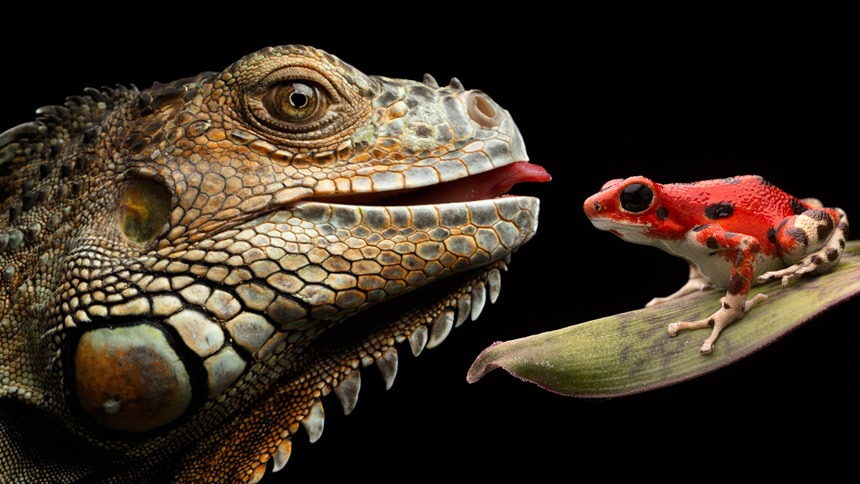
Reptiles vs. Amphibians: The Major Differences
Amphibians and reptiles both belong to the group of animals called vertebrates as they contain backbone in their body. More specifically, both are cold-blooded vertebrates. One may easily confuse between the two because they share many related features.
Owing to their similarities and close evolutionary relationship, both of these groups are studied under Herpetology, in Greek Herpo means “to crawl” or “creep”.
All of the land animals track their evolutionary ancestry to marine animals (dominantly fish). Amphibians and reptiles were among the early animals that moved away from the aquatic environment and started colonizing the land and terrestrial ecosystems.
These were the first tetrapod descendants of a group of sarcopterygian fish (lobe-finned). In another fossil discovery, researchers published the existence of Tiktaalik roseae “tetrapod-like fish”, which appeared as an intermediate between finned fish and tetrapods having limbs. This organism supposedly lived in shallow waters around 375 million years ago.
Well, now you know the basics of where they came from. But what about their differences? Keep reading to find out!
Page Contents
The Differences Between Reptiles & Amphibians
While both groups share many similarities, they possess even more differences which we will discuss here for your understanding. These differences which arose have their roots in genetic mutations/altering and pressure posed by natural selection.
Amphibians
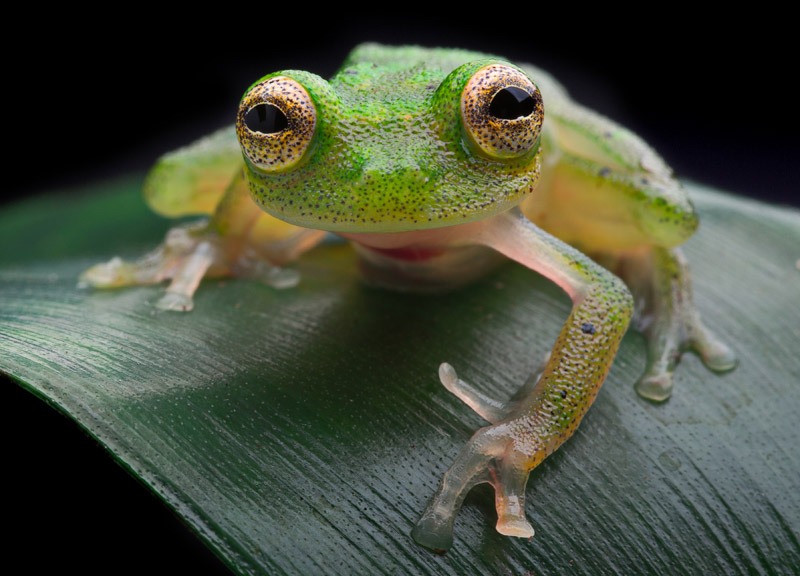
Amphibians were the first which localized on land, although they still need water for reproduction purposes. Hence from Greek origin amphibian means ‘double life’ as they live on land and part of their life in water also.
Amphibians initially evolved into a great number of species but a lot of these went extinct over time owing to abiotic stress acting as a filter for only the fittest species to survive.
Because amphibians live in marginal conditions and need both land and water in the vicinity for their living and reproduction, any change in either environment adversely affects their survivability.
Owing to changing environments including human interventions, we lost a broad spectrum of amphibian diversity, what we see in the present day is only a fraction of initial diversity. Of course, present-day species are more fit than ones that have gone extinct but degrading water quality and other environmental factors still pose a great threat to their survival.
Characteristics:
Amphibians evolved over 370 million years ago in the late Devonian period. These were dominant during Carboniferous and Permian periods.
- They survive in habitats containing water bodies due to their reproduction requirements.
- Amphibians have external fertilization and they fertilize in water. Where a huge number of gummy eggs and sperms are released.
- Most amphibians undergo metamorphosis

Amphibians lay their eggs in water from which larvae produce. Larvae have external gills while adults have lungs for gaseous exchange. Gills are later turned into redundant structures and degraded through the process of apoptosis.
At the larval stage, amphibians have two-chambered hearts similar to fishes in which blood is pumped through the girls for oxygenation and then spread into the body and then back to the heart. When they mature into adults they have three-chambered hearts i.e. one ventricle and two atria.
- Amphibians have permeable skin and use their skin for gaseous exchange while some species rely entirely on their skin. Amphibians produce toxins from their skin which they use as protective mechanisms against their predators.
- Most amphibians excrete ammonia and Urea. In aquatic environments, in larvae and some adults, which have excess water supply, ammonia is the principal form of excretory waste, produced in large quantities of diluted urine, however terrestrial species with limited water supply excrete a less toxic form of nitrogenous waste, Urea. Some frogs with limited water supply also excrete uric acid.
- Amphibians belonging to tetrapod have four limbs except for a few salamander species and caecilians which have reduced or no limbs.
- Many amphibians exhibit bio-fluoresce. They shed their skin frequently.
- The study of amphibians is called batrachology. Three modern amphibian orders are Anura (toads and frogs) Apoda (caecilians) and Urodela (salamanders). Amphibians have around 8000 species while 90% of these are frogs.
- The smallest amphibian, a frog Paedophyrene amauensis is just 7.7 mm in length while the largest one is the South china great salamander which is 1.8m long.
Reptiles
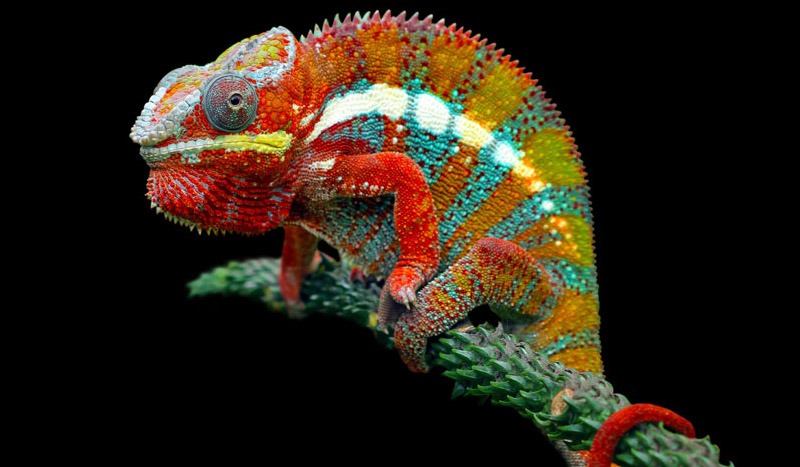
Reptiles were the next group of animals on the evolutionary ladder that succeeded amphibians and developed characters that helped them colonize on land with complete independence from the need for an aquatic environment.
Their development of the ‘amniotic egg’ was the primary character that freed them from water dependence. The egg was covered in layers containing amniotic fluid which protected the embryo from desiccation or injury.
The egg was either laid on land or kept safe inside the body. When the development of the fetus was complete it was given birth or hatched out of the egg.
This major evolution allowed the reptiles to colonize the land to a far greater extent than amphibians could. Along with this character, reptiles also developed scales on their body which provided them with resilient skin and reduced water loss through the skin.
Characteristics:
The earliest known reptiles evolved 312 million years ago during the Carboniferous era.
- Reptiles usually have internal fertilization. Most reptilian species are oviparous while a few are viviparous. Oviparous species lay eggs containing amniotic fluid and covered with a hard shell while viviparous species complete fetus development inside the body and give birth to young ones. Amniotic eggs have albumin which supplies the embryo with protein and water, and an egg yolk that provides energy to the embryo.
- Reptiles do not show metamorphosis; young ones are similar to the adult ones, no larvae-like structure is formed.
- Reptilian hearts are three-chambered having two atria and one ventricle which is variably partitioned. The heart of some squamates species like pythons becomes effectively four-chambered while contracting their ventricle has a muscular range that divides the ventricle during the systole which divides it into two parts. The Crocodilian heart, which is similar to birds, has four chambers.
- Reptiles owing to their water independence, produce uric acid and urea as a major excretory product requiring little amounts of water for waste removal
- Reptiles have a process of ecdysis or molting through which they shed or remove their skin; it occurs throughout their lifetime in several periods. Skin shedding frequency is different, ranging from each 5-6 weeks in young while 4-5 times a year in adults.
- Reptiles are tetrapod vertebrates; they usually have four limbs while some species like snakes have degraded limbs from their ancestors.
- Reptiles range in size from a tiny gecko which is maximum up to 17 mm in length while the largest reptile saltwater crocodile can be as long as 17 feet in length.
Class Reptilia contains a great variety of species that are further classified into four living clades. These are the 25 species of Crocodilia, 2 species of Sphenodontia, nearly 9,200 Squamata species, and the Testudines, having about 325 species.
Comparison Table – Amphibians vs. Reptiles
| Amphibians | Reptiles | |
|---|---|---|
| Evolution | Evolved 370 million years ago (late Devonian era) | Evolved 312 million years ago (Carboniferous era) |
| Fertilization | External fertilization | Internal fertilization |
| Body temp | Cold-blooded, ectotherms usually | Cold-blooded, ectotherms, a few poikilotherms |
| Eggs | Jelly like eggs are laid in water without a hard protective coating | Eggs contain amniotic fluid and covered with a leathery shell |
| Development | Embryo develops into larvae which after metamorphosis forms adult | Embryo develops into young reptiles similar to adults which grow in size |
| Breathing | Use their skin for gaseous exchange, sometimes lung also | Depend mostly or entirely on their lungs |
| Skin Texture | Moist, smooth, porous, and often sticky with numerous mucus glands | Dry scales arranged in a particular pattern. The actual skin is found underneath the dry scales, which are made of keratin |
| Skin function | Use their skin for gaseous exchange, protection and toxic secretions from associated glands provide defense against predators | Protection and preserving water loss |
| Toxin production | Produce toxins usually from glands under their skin | Have toxin glands which secrete toxins through teeth or nails |
| Appearance | Smooth, slimy appearance | Rough, bumpy, scales |
| Limbs | Have four limbs except for a few salamander species and caecilians which have reduced or no limbs | Usually have four limbs, species like snakes have no limbs |
| Heart morphology | At the larval stage, amphibians have a two-chambered heart. Maturing into adults they have three-chambered, heart one ventricle, and two atria | Reptilian hearts are three-chambered, having two atria and one variably partitioned ventricle. Crocodilian heart is four-chambered |
| Diversity | 3 modern amphibian orders are Anura (toads and frogs), apoda (caecilians) and urodela (salamanders) having around 8000 species | Four living clades i.e., crocodilia, sphenodontia, squamata, and testudines have more than 10000 species |
| Size comparison | Smallest amphibian, a frog Paedophyrene amauensis is just 7.7 mm in length while the largest one is the south china great salamander which is 1.8m long | Tiny gecko which is maximum up to 17 mm length while largest reptile saltwater crocodile can be as long as 17 feet in length |
| Scientific study | The study of amphibians is called batrachology | Reptiles are studied under herpetology |
| Skin shedding | Amphibians shed their skin very often | Reptiles moult each 5-6 weeks in young while 4-5 times a year in adults |
| Survivability | They survive in habitats containing water bodies | These can survive in almost all habitats, even deserts |
| Excretion | Mostly excrete ammonia and urea | Usually excrete urea and uric acid |
| Vision | Amphibians have a narrow color range and can discriminate only among few colors | Reptiles have “double cone” cells in their eyes enabling them sharp color vision can also see ultraviolet wavelengths |
| Tongue | Amphibians mostly have a full tongue but some species have bifurcated tongue at the tip | Reptiles are usually characterized by a bifurcated tongue as in snakes |
| Example | Frogs, toads, salamanders | Lizards, snakes, crocodiles, turtles |
Examples of Amphibians
Listed below are two great examples of amphibians.
Frogs
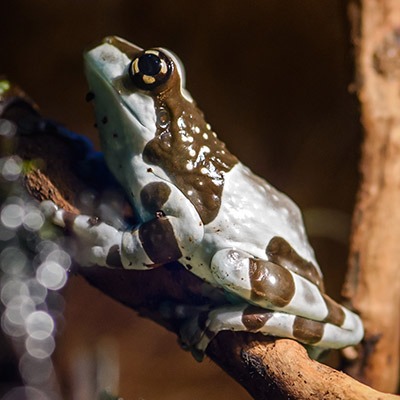
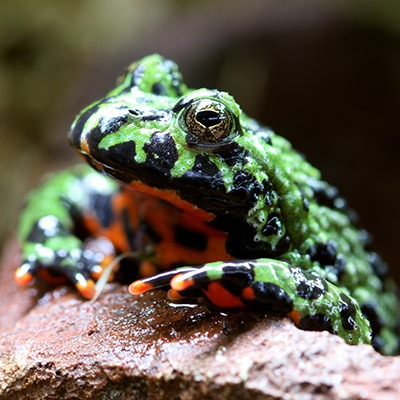
Frogs belong to the Anura order and are tailless amphibians. They are aquatic mostly while some of them inhabit both land and water and some inhabit land only. A mature frog has protruding eyes and a stout body and two pairs of limbs. Fore-limbs are weak and shorter in length while rear legs are powerful and long to make jumps.
Similar to other amphibians, the skin of frogs is kept moist and the primary function is respiration. Frogs also have functional lungs. Harmful secretions are produced from the skin of frogs by many glands, which act as a defense mechanism against predators.
Frogs are known to have a long tongue which can be one-third of their body length. Adult frogs are carnivores and they use their sticky tongue to catch insects and other small organisms.
Frogs usually breed during the rainy season in freshwater. They make mating secretions or mating calls to attract their mates. Eggs are laid in water where they are externally fertilized and develop into tadpole-like larvae which transform into adult frogs through metamorphosis.
Salamanders
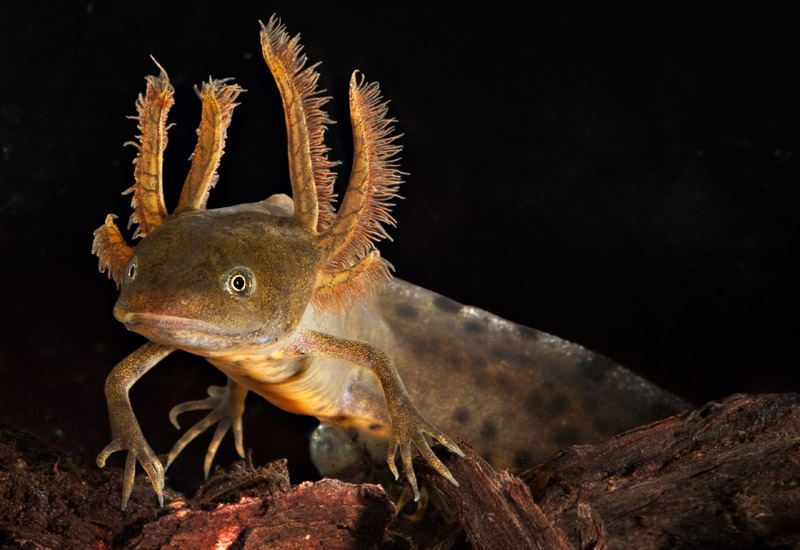
A salamander has an appearance similar to the lizard and an elongated body with short limbs and a tail. It is a diverse group with some species being entirely aquatic, other terrestrial, and some switching over both types of environment.
Salamanders have permeable skin and it is kept moist with the help of numerous glands. The skin is shed periodically.
The skin has unique color patterns which allow them to camouflage in their environment and escape predators. Most salamanders are carnivorous and they feed on small mammals, fishes, and crabs. In 90% of cases, fertilization is internal where males spread the sperms on the ground which are then picked by the female.
In a few weeks, larvae come out of the eggs and spend most of the time in the water after metamorphosis it develops into a mature salamander.
Examples of Reptiles
Listed below are just two examples of reptiles. Other examples includes snakes, lizards, and monitors.
Crocodiles

Crocodiles are usually aquatic reptiles and they have a length of about 2 meters and can weigh around 1000 kg. Keratinized scales completely cover their long streamlined body. This helps with their survival and mobility in water. Crocodiles have large teeth, two short pairs of limbs, webbed feet with claws, and a heavy tail.
It has a structure that allows it to keep its nose, eyes, and ears outside the water, while its body remains submerged.
Crocodiles are cold-blooded animals and their body temperature is adjusted in accordance to their environment therefore they alternate between Sun and shade to keep their body temperature maintained. They dig burrows during cold weather to keep their body warm.
They have internal fertilization. The eggs are laid on the land. It takes two to three months for development and the young ones hatch out of the eggs. The mother protects the young ones for many weeks or months.
Turtles

Turtles belong to reptiles that have their body enclosed inside a hard shell. Shell is made up of bones and cartilage and is a necessary organ of the body. This shell is not shed and is maintained throughout life. Some species of turtles can live on land while others live in water.
They have hard beaks on their heads with jaws which help them cut and chew food. They move very slowly with two pairs of webbed feet. Sea turtles can have flappers in place of feet.
They have internal fertilization and eggs are laid on land from which young ones hatch out. After birth, no parental care is provided to the young turtles.
Life presents us with a great variety, from prokaryotic unicellular to eukaryotic multicellular. Here we had a brief overview of some similarities and mainly focused on differences among amphibians and reptiles. We hope this will add to your understanding and knowledge.

Leave a Reply